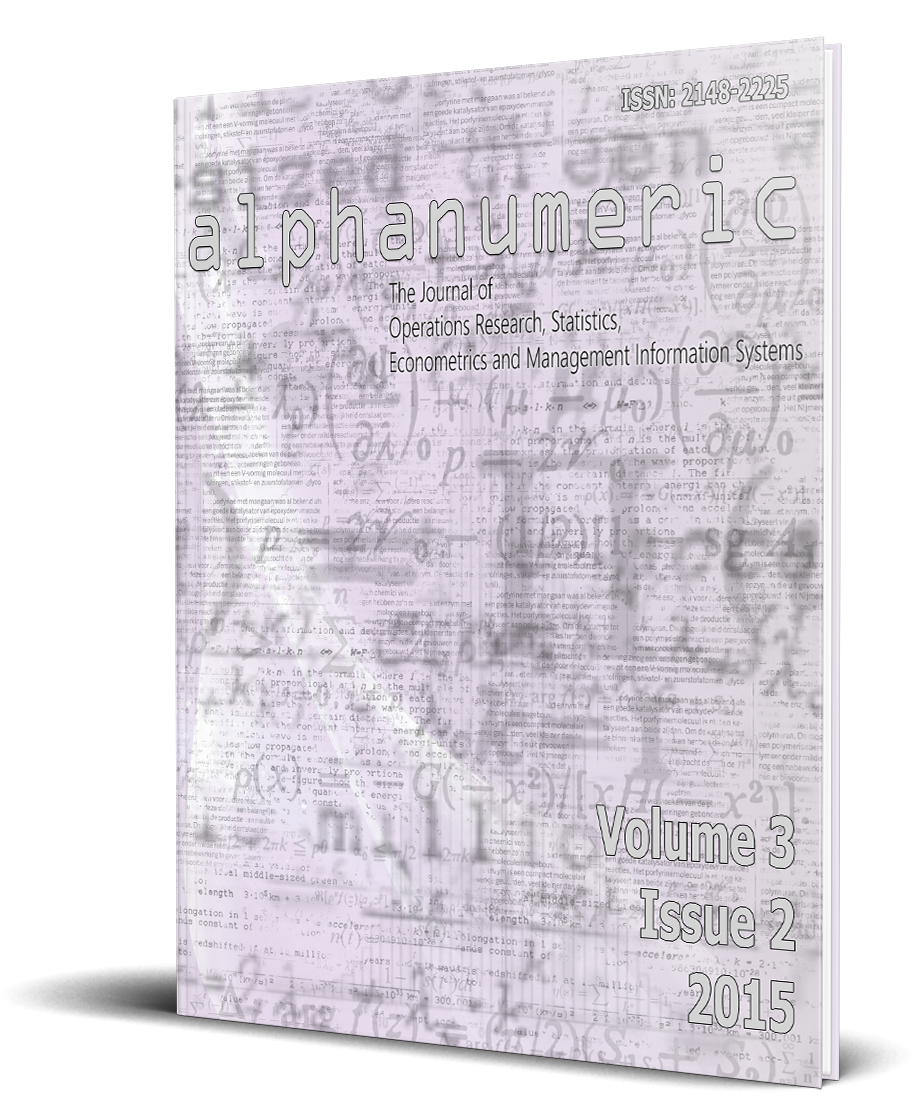
alphanumeric journal
The Journal of Operations Research, Statistics, Econometrics and Management Information Systems
A Comparison of Artificial Neural Networks and Multiple Linear Regression Models As Predictors of Discard Rates In Plastic Injection Molding
Vesile Sinem Arıkan Kargı, Ph.D.
Abstract
In today’s global competitive environment, it is important to be able to evaluate the efficient use of a firms’ resources. The aim of this study is to predict the discard rate for headlight frames before the project of an automotive sub-industry firm in Bursa. For this prediction, the multilayer perceptron model, the radial basis function network model and multiple linear regression models were used. Matlab R2010b software was used for the multilayer perceptron model and radial basis function network solutions, and SPSS 13 packet software was used to solve the multiple linear regressions. Comparing the three models, the multilayer perceptron model was identified as the best predictive model.
Keywords: Artificial Neural Networks, Discard Rate, Multilayer Perceptron Model, Multiple Linear Regression Model, Radial Basis Function Network Model
Plastik Enjeksiyon Kalıplamada Iskarta Oranı Tahmininde Yapay Sinir Ağları ve Çoklu Doğrusal Regresyon Modellerin Karşılaştırılması
Öz
Günümüz küresel rekabet koşullarında firmaların kaynakları etkin kullanarak değerlendirmesi oldukça önemli bir konudur. Bu çalışmanın amacı Bursa’da bir otomotiv yan sanayi firmasının proje öncesinde far çerçeve parçasının ıskarta oranını tahmin etmektir. Bu tahmin için yapay sinir ağ modellerinden çok katmanlı algılayıcı model, radyal tabanlı fonksiyon ağ modeli ve çoklu doğrusal regresyon model teknikleri kullanılmıştır. Çalışmada çok katmanlı algılayıcı model ve radyal tabanlı fonksiyon ağ model çözümleri için Matlab R2010b programı, çoklu doğrusal regresyon model çözümü için SPSS 13 paket programı kullanılmıştır. Firmanın ıskarta oranı tahmininde bu üç model kıyaslanmış ve en uygun modelin çok katmanlı algılayıcı model olduğu belirlenmiştir.
Anahtar Kelimeler: Iskarta Oranı, Radyal Tabanlı Fonksiyon Ağ Modeli, Yapay Sinir Ağları, Çok Katmanlı Algılayıcı Model, Çoklu Doğrusal Regresyon Model
Suggested citation
(). A Comparison of Artificial Neural Networks and Multiple Linear Regression Models As Predictors of Discard Rates In Plastic Injection Molding. Alphanumeric Journal, 3(2), 65-72. http://dx.doi.org/10.17093/aj.2015.3.2.5000149667
References
- Arıkan Kargı, V.S.(2015). Yapay Sinir Ağ Modelleri ve Bir Tekstil Firmasında Uygulama. Bursa: Ekin Yayınevi.
- Womack, P.J., Daniel J.,T. and Ross, D.(1990). Dünyayı Değiştiren Makine, Çeviri Osman Kabak. İstanbul: Panel Matbaacılık.
- Özek ,C. and Çelik, Y. H.(2011). Plastik Enjeksiyon Kalıplarında Enjeksiyon Sürelerinin Yapay Sinir Ağları ile Modellenmesi. Fırat Üniv. Mühendislik Bilimleri Dergisi, 23(1), 35-42.
- Chang, P., Hwang, S., Lee, H. and Huang, D.(2007). Development of an External-Type Microinjection Molding Module for Thermoplastic Polymer. Journal of Materials Processing Technology, 184(1-3), 163-172.
- Rewal,N. and Toncich,D.(1998). Predicting Part Quality In Injection Molding Using Artificial Neural Networks. Journal of Injection Molding Technology, 4(2), 109-119.
- Lau, H.C.W., Wong, T.T. and Pun, K.F. (1999). Neural-Fuzzy Modeling of Plastic Injection Molding Machine for Intelligent Control. Expert System with Applications, 17(1), 33–43.
- Sadeghi, B.H.M.(2000). A BP- Neural Network Predictor Model for Plastic Injection Molding Process. Journal of Materials Processing Technology,103(3), 411–416.
- Zhu, J. and Chen, J.C.(2006). Fuzzy Neural Network Based in Process Mixed Material Caused Flash Prediction (FNN-IPMFP) in Injection Molding Operations. International Journal of Advanced Manufacturing Technology, 29(1), 308-316.
- Öktem, H., Erzurumlu, T. and Erzincanlı, F.(2006). Prediction of Minimum Surface Roughness in End Milling Mold Parts Using Neural Network and Genetic Algorithm. Materials and Design, 27(1), 735-744.
- Changyu, S., Lixia, W. and Qian, L.(2007). Optimization of Injection Molding Process Parameters Using Combination of Artificial Neural Network and Genetic Algorithm Method. Journal of Materials Processing Technology, 183(1), 412-418.
- Karataş, Ç., Sözen, A., Arcaklıoğlu and E., Ergüney, S.(2007). Modelling of Yield Length in The Mould of Commercial Plastics Using Artificial Neural Networks. Materials and Design, 28(1), 278-286.
- Kuo-Ming T. and Hao-Jhih L.(2015). “Comparison of Injection Molding Process Windows for Plastic Lens Established By Artificial Neural Network and Response Surface Methodology”, International Journal of Advanced Manufacturing Technology, 77(9), 1599- 1611.
- Elmas, Ç.(2011). Yapay Zeka Uygulamaları, Seçkin yayınevi, Ankara.
- Lippmann, R. P.(1987). An Introduction to Computing with Neural Nets, IEEE ASSP Magazine, 4(2), 4-22.
- Öztemel, E.(2003). Yapay Sinir Ağları, Papatya Yayıncılık, İstanbul.
- Kim, K. B. and Kim, C. K.(2004). “Performance Improvement of RBF Network Using ART2 Algorithm and Fuzzy Logic System” , Australia Conference on Artificial Intelligence.
- Haykın, S.(1999). Neural Networks: A Comprehensive Foundation, New Jersey.
- Kaynar, O.,Taştan, S. and Demirkoparan, F.(2010). “Ham Petrol Fiyatlarının Yapay Sinir Ağları ile Tahmini”, Ege Academic Review, 10(2), 575-596.
- Tso GK and Yau KK.(2007). “Predicting Electricity Energy Consumption: A Comparision of Regression Analysis, Decision Tree and Neural Networks”, Energy, 32(9), 1761-1768.
2015.03.02.STAT.04
alphanumeric journal
Pages 65-72
Received: Nov. 4, 2015
Accepted: Dec. 22, 2015
Published: Dec. 31, 2015
2015 Arıkan Kargı, VS.
This is an Open Access article, licensed under Creative Commons Attribution-NonCommercial 4.0 International License.

scan QR code to access this article from your mobile device
Contact Us
Faculty of Transportation and Logistics, Istanbul University
Beyazit
Campus 34452 Fatih/Istanbul/Türkiye
Bahadır Fatih Yıldırım, Ph.D.
editor@alphanumericjournal.com
+ 90
(212) 440 00 00 - 13219
alphanumeric journal
alphanumeric journal has been publishing as "International Peer-Reviewed Journal" every six months since 2013. alphanumeric serves as a vehicle for researchers and practitioners in the field of quantitative methods, and is enabling a process of sharing in all fields related to the operations research, statistics, econometrics and management informations systems in order to enhance the quality on a globe scale.

